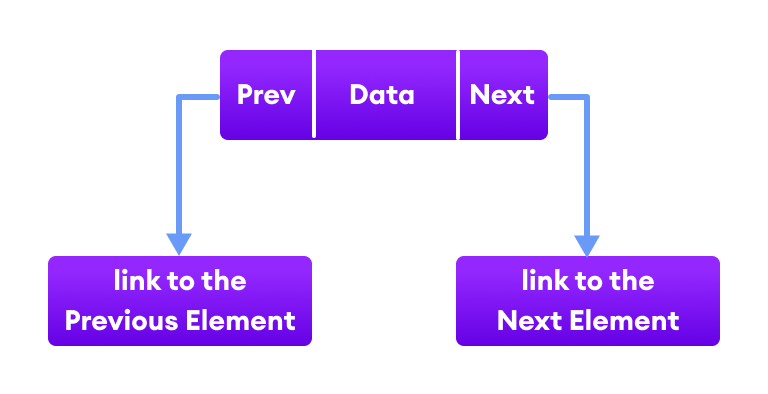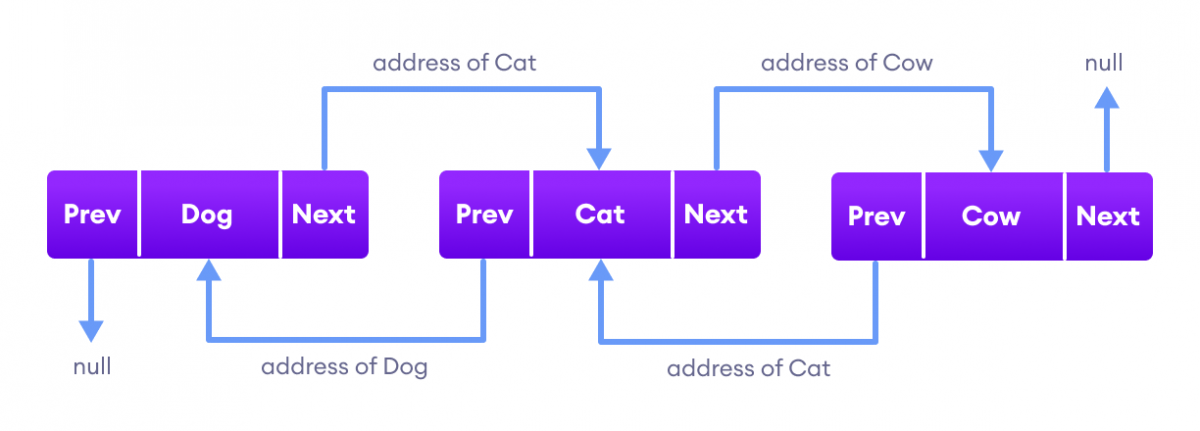The LinkedList class of the Java collections framework provides the functionality of the linked list data structure (doubly linkedlist).

Each element in a linked list is known as a node. It consists of 3 fields:
- Prev - stores an address of the previous element in the list. It is
nullfor the first element - Next - stores an address of the next element in the list. It is
nullfor the last element - Data - stores the actual data
Creating a Java LinkedList
Here is how we can create linked lists in Java:
LinkedList<Type> linkedList = new LinkedList<>();
Here, Type indicates the type of a linked list. For example,
// create Integer type linked list
LinkedList<Integer> linkedList = new LinkedList<>();
// create String type linked list
LinkedList<String> linkedList = new LinkedList<>();
Example: Create LinkedList in Java
import java.util.LinkedList;
class Main {
public static void main(String[] args){
// create linkedlist
LinkedList<String> animals = new LinkedList<>();
// Add elements to LinkedList
animals.add("Dog");
animals.add("Cat");
animals.add("Cow");
System.out.println("LinkedList: " + animals);
}
}
Output
LinkedList: [Dog, Cat, Cow]
In the above example, we have created a LinkedList named animals.
Here, we have used the add() method to add elements to the LinkedList. We will learn more about the add() method later in this tutorial.
Working of a Java LinkedList
Elements in linked lists are not stored in sequence. Instead, they are scattered and connected through links (Prev and Next).

Here we have 3 elements in a linked list.
- Dog - it is the first element that holds null as previous address and the address of Cat as the next address
- Cat - it is the second element that holds an address of Dog as the previous address and the address of Cow as the next address
- Cow - it is the last element that holds the address of Cat as the previous address and null as the next element
To learn more, visit the LinkedList Data Structure.
Methods of Java LinkedList
LinkedList provides various methods that allow us to perform different operations in linked lists. We will look at four commonly used LinkedList Operators in this tutorial:
- Add elements
- Access elements
- Change elements
- Remove elements
1. Add elements to a LinkedList
We can use the add() method to add an element (node) at the end of the LinkedList. For example,
import java.util.LinkedList;
class Main {
public static void main(String[] args){
// create linkedlist
LinkedList<String> animals = new LinkedList<>();
// add() method without the index parameter
animals.add("Dog");
animals.add("Cat");
animals.add("Cow");
System.out.println("LinkedList: " + animals);
// add() method with the index parameter
animals.add(1, "Horse");
System.out.println("Updated LinkedList: " + animals);
}
}
Output
LinkedList: [Dog, Cat, Cow] Updated LinkedList: [Dog, Horse, Cat, Cow]
In the above example, we have created a LinkedList named animals. Here, we have used the add() method to add elements to animals.
Notice the statement,
animals.add(1, "Horse");
Here, we have used the index number parameter. It is an optional parameter that specifies the position where the new element is added.
To learn more about adding elements to LinkedList, visit Java program to add elements to LinkedList.
2. Access LinkedList elements
The get() method of the LinkedList class is used to access an element from the LinkedList. For example,
import java.util.LinkedList;
class Main {
public static void main(String[] args) {
LinkedList<String> languages = new LinkedList<>();
// add elements in the linked list
languages.add("Python");
languages.add("Java");
languages.add("JavaScript");
System.out.println("LinkedList: " + languages);
// get the element from the linked list
String str = languages.get(1);
System.out.print("Element at index 1: " + str);
}
}
Output
LinkedList: [Python, Java, JavaScript] Element at index 1: Java
In the above example, we have used the get() method with parameter 1. Here, the method returns the element at index 1.
We can also access elements of the LinkedList using the iterator() and the listIterator() method. To learn more, visit the Java program to access elements of LinkedList.
3. Change Elements of a LinkedList
The set() method of LinkedList class is used to change elements of the LinkedList. For example,
import java.util.LinkedList;
class Main {
public static void main(String[] args) {
LinkedList<String> languages = new LinkedList<>();
// add elements in the linked list
languages.add("Java");
languages.add("Python");
languages.add("JavaScript");
languages.add("Java");
System.out.println("LinkedList: " + languages);
// change elements at index 3
languages.set(3, "Kotlin");
System.out.println("Updated LinkedList: " + languages);
}
}
Output
LinkedList: [Java, Python, JavaScript, Java] Updated LinkedList: [Java, Python, JavaScript, Kotlin]
In the above example, we have created a LinkedList named languages. Notice the line,
languages.set(3, "Kotlin");
Here, the set() method changes the element at index 3 to Kotlin.
4. Remove element from a LinkedList
The remove() method of the LinkedList class is used to remove an element from the LinkedList. For example,
import java.util.LinkedList;
class Main {
public static void main(String[] args) {
LinkedList<String> languages = new LinkedList<>();
// add elements in LinkedList
languages.add("Java");
languages.add("Python");
languages.add("JavaScript");
languages.add("Kotlin");
System.out.println("LinkedList: " + languages);
// remove elements from index 1
String str = languages.remove(1);
System.out.println("Removed Element: " + str);
System.out.println("Updated LinkedList: " + languages);
}
}
Output
LinkedList: [Java, Python, JavaScript, Kotlin] Removed Element: Python New LinkedList: [Java, JavaScript, Kotlin]
Here, the remove() method takes the index number as the parameter. And, removes the element specified by the index number.
To learn more about removing elements from the linkedlist, visit the Java program to remove elements from LinkedList..
Other Methods
| Methods | Description |
|---|---|
contains() |
checks if the LinkedList contains the element |
indexOf() |
returns the index of the first occurrence of the element |
lastIndexOf() |
returns the index of the last occurrence of the element |
clear() |
removes all the elements of the LinkedList |
iterator() |
returns an iterator to iterate over LinkedList |
LinkedList as Deque and Queue
Since the LinkedList class also implements the Queue and the Deque interface, it can implement methods of these interfaces as well. Here are some of the commonly used methods:
| Methods | Descriptions |
|---|---|
addFirst() |
adds the specified element at the beginning of the linked list |
addLast() |
adds the specified element at the end of the linked list |
getFirst() |
returns the first element |
getLast() |
returns the last element |
removeFirst() |
removes the first element |
removeLast() |
removes the last element |
peek() |
returns the first element (head) of the linked list |
poll() |
returns and removes the first element from the linked list |
offer() |
adds the specified element at the end of the linked list |
Example: Java LinkedList as Queue
import java.util.LinkedList;
import java.util.Queue;
class Main {
public static void main(String[] args) {
Queue<String> languages = new LinkedList<>();
// add elements
languages.add("Python");
languages.add("Java");
languages.add("C");
System.out.println("LinkedList: " + languages);
// access the first element
String str1 = languages.peek();
System.out.println("Accessed Element: " + str1);
// access and remove the first element
String str2 = languages.poll();
System.out.println("Removed Element: " + str2);
System.out.println("LinkedList after poll(): " + languages);
// add element at the end
languages.offer("Swift");
System.out.println("LinkedList after offer(): " + languages);
}
}
Output
LinkedList: [Python, Java, C] Accessed Element: Python Removed Element: Python LinkedList after poll(): [Java, C] LinkedList after offer(): [Java, C, Swift]
Example: LinkedList as Deque
import java.util.LinkedList;
import java.util.Deque;
class Main {
public static void main(String[] args){
Deque<String> animals = new LinkedList<>();
// add element at the beginning
animals.add("Cow");
System.out.println("LinkedList: " + animals);
animals.addFirst("Dog");
System.out.println("LinkedList after addFirst(): " + animals);
// add elements at the end
animals.addLast("Zebra");
System.out.println("LinkedList after addLast(): " + animals);
// remove the first element
animals.removeFirst();
System.out.println("LinkedList after removeFirst(): " + animals);
// remove the last element
animals.removeLast();
System.out.println("LinkedList after removeLast(): " + animals);
}
}
Output
LinkedList: [Cow] LinkedList after addFirst(): [Dog, Cow] LinkedList after addLast(): [Dog, Cow, Zebra] LinkedList after removeFirst(): [Cow, Zebra] LinkedList after removeLast(): [Cow]
Iterating through LinkedList
We can use the Java for-each loop to iterate through LinkedList. For example,
import java.util.LinkedList;
class Main {
public static void main(String[] args) {
// Creating a linked list
LinkedList<String> animals = new LinkedList<>();
animals.add("Cow");
animals.add("Cat");
animals.add("Dog");
System.out.println("LinkedList: " + animals);
// Using forEach loop
System.out.println("Accessing linked list elements:");
for(String animal: animals) {
System.out.print(animal);
System.out.print(", ");
}
}
}
Output
LinkedList: [Cow, Cat, Dog] Accessing linked list elements: Cow, Cat, Dog,
LinkedList Vs. ArrayList
Both the Java ArrayList and LinkedList implements the List interface of the Collections framework. However, there exists some difference between them.
| LinkedList | ArrayList |
|---|---|
Implements List, Queue, and Deque interfaces. |
Implements List interface. |
| Stores 3 values (previous address, data, and next address) in a single position. | Stores a single value in a single position. |
| Provides the doubly-linked list implementation. | Provides a resizable array implementation. |
Whenever an element is added, prev and next address are changed. |
Whenever an element is added, all elements after that position are shifted. |
| To access an element, we need to iterate from the beginning to the element. | Can randomly access elements using indexes. |
Note: We can also create a LinkedList using interfaces in Java. For example,
// create linkedlist using List
List<String> animals1 = new LinkedList<>();
// creating linkedlist using Queue
Queue<String> animals2 = new LinkedList<>();
// creating linkedlist using Deque
Deque<String> animals3 = new LinkedList<>();
Here, if the LinkedList is created using one interface, then we cannot use methods provided by other interfaces. That is, animals1 cannot use methods specific to Queue and Deque interfaces.